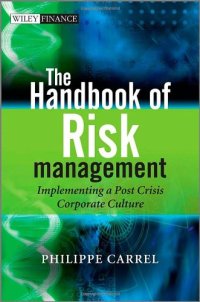"The risk management revolution, which began with the spectacular failure of corporate governance and regulatory guidelines, has led us to an entirely new culture of risk management. Each and every firm and institution throughout the finance industry must now identify and understand risk, and regulators must inspire this endeavour." "The Handbook of Risk Management is an introduction to the next generation of risk management. Proposing a practical 5 step methodology for creating and implementing tomorrow's risk management frameworks, it is strongly rooted within the corporate culture of each financial institution. This new approach relies on transparency, exchange of information and risk intelligence gathered from inside and outside the institution. It involves all moving parts, all thinking entities across the enterprise in order to foster capabilities to adapt, anticipate and prevent risks from becoming losses. It is a true build-up of 'corporate DNA', an absolute requirement moving forward for firms to develop a deep culture of risk management and enable them to face unknown challenges." "This book:" "--Provides a detailed methodology to analyse risk, translate risk policies into risk targets and distribute responsibilities and capabilities accordingly" "-proposes multiple channel information workflows for critical risk data to be conveyed from operational units to decision makers and allow for timely action to be taken" "-suggests innovative ways for combining quantitative measurements of market, credit and operational risks as well as methods to gather risk intelligence from inside and outside firms" "-makes a departure from traditional risk management frameworks favouring widespread exchanges of information and direct, unbiased communications" "-fosters the foundations of a brand new culture of transparency within the financial industry" "-suggests new ways for regulators and the financial market community to gather and redistribute risk intelligence and benchmarks" "The book is based on research in existing and new methodologies, supported with interviews of executives from banks, asset management companies, private wealth managers, hedge funds, administrators, regulators and corporates globally on where they intend to focus their risk management efforts moving forward. Through worked examples and real life case studies, the author gathers the very latest trends observed globally across the finance industry into simple sets of guidelines designed to inspire the layout of post crisis risk management frameworks. He also suggests new steps for the regulators and market participants to elevate their communication, creating a new spirit of constructive cooperation in order to better fulfil the social responsibility of managing financial risks." "In this book, Philippe Carrel creates a new standard to understand and communicate risk intelligence, providing a source of inspiration and a set of guidelines where risk managers, executives, consultants and regulators can find the essential drivers and key components of their own risk management culture."--Jacket. �Read more...
Abstract: This handbook shows a firm how to repurpose its risk management in order to design and implement a corporate culture which involves all business units and individuals at each level of the hierarchy, how to analyse its risk appetite, translate it into risk policies and risk targets and distribute responsibilities and capabilities accordingly. �Read more...
Download the book The handbook of risk management : implementing a post-crisis corporate culture for free or read online
Continue reading on any device:


